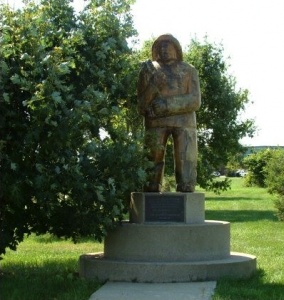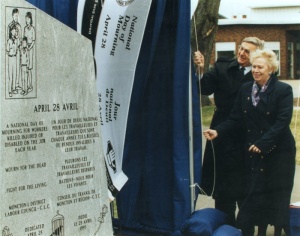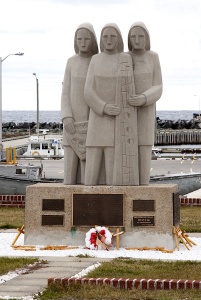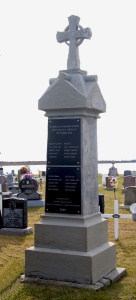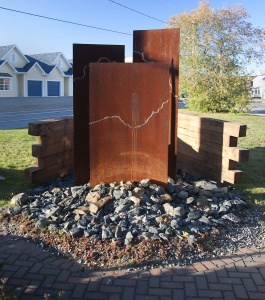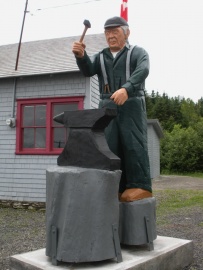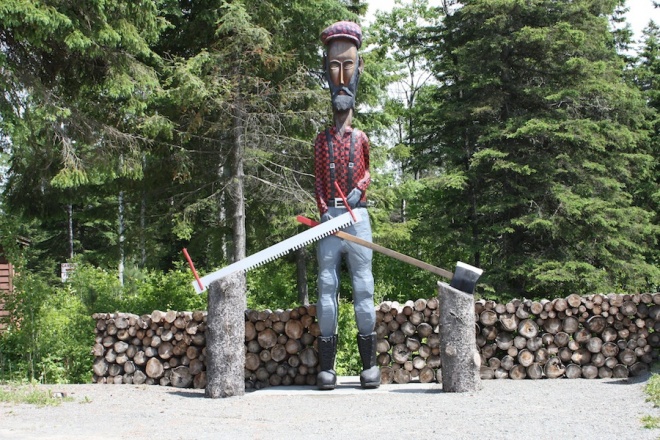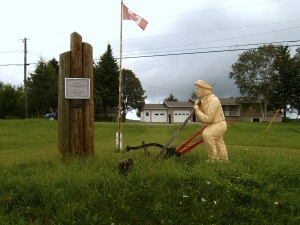Historic Workers’ Monuments in Acadian New Brunswick
par Lang, Nicole
In Acadian regions of New Brunswick, historic landmarks and monuments are dedicated to workers and tradesmen. Such places enable visitors to discover the significance these occupations hold in a community’s popular culture. These worker’s monuments are the result of the dedication of the various groups active in the community: labour councils, unions, families, municipal officials, and even employers and the State. Some monuments were set up in remembrance of tragic work-related events. Others focus on the contributions of various groups or individuals who have distinguished themselves in their work or within their community. In all cases, the landmarks and monuments highlight the workers’ contribution to the community.
Article disponible en français : Lieux historiques ouvriers en Acadie du Nouveau-Brunswick
The Origins of the Workers, Monument
The term “workers’ monument” (NOTE 1) was coined in the context
of the “laborlore” tradition, which was first attested in the 1950s in one of
Archie Green’s works. A shipwright and scholar,
Green was born in Canada and settled in California. He wanted to bring people’s
attention to some the trade and occupation lore that often went unmentioned in
folk studies, as well as in the official history of various trades and
occupations. In a paper written in 1995, Green gives many examples of workers’
monuments in the United States: statues, plaques, mosaics, burial grounds,
architectural ornaments and industrial sites (NOTE 2). Since then, trade and
occupational historians, practitioners of public history and various
organisations have taken an interest in these historic sites (NOTE 3).
Workers’ monuments in Acadia are a part of an “unofficial” popular culture that exists as a result of local initiatives and public financing. Very few of these memorials were created with the objective of promoting tourism or of commercializing Acadian culture. They actually arose from a desire to illustrate the significance of the workers’ role in the community, the economy and the province.
Workers’ monuments can take many shapes and forms. Some are closer to the traditional memorial – such as commemorative plaques – while others are public works of art – such as the Fishermen’s Monument in Escuminac. Several have been erected in public places: in parks, in front of municipal buildings or museums. A few can be found in more private places, such as in front of a house or a family business, along an abandoned railway or in a forest. A large number of them commemorate tragic deaths or remind the community of trade or work-related hazards. All workers’ monuments are examples of respect and dignity owed to workers, as well as how such occupations are such an important part of the Acadian national identity.
A Few Acadian Workers’ Monuments and Historic Landmarks
The Fishermen’s Monument – Escuminac
The Fishermen’s Monument is without a doubt the most impressive labour monument in New Brunswick, as well as its most famous. It commemorates the worst work-related disaster ever to have occurred in the province. The tragedy took place on the night of June 19, 1959. That night, 35 fishermen – men and teenagers – disappeared in a violent coastal storm (NOTE 4). The event came to be known as the Désastre d'Escuminac, largely because, back then, the Escuminac wharf (located at the mouth of the Miramichi bay) was once the centre of fishing activity for several neighbouring communities (NOTE 5).
Artist Claude Roussel was living in Edmundston at the time of the tragedy. He was so moved by the catastrophe that he decided to create a sculpture to honour the fishermen. At that time, he first made an initial 60 cm wooden sculpture as a model for the piece titled The Fishermen – Les Pêcheurs. In 1969, as a result of the financial support offered by the Beaverbrook Foundation, Roussel sculpted the work in stone. The Escuminac region’s inhabitants then decided to launch fund-raising campaigns. The funds raised were intended to pay for the base of the monument, as well as for the bronze plaques on which the names of victims and survivors were inscribed.
Today the monument stands on the Escuminac wharf. The various figures in the sculpture do not represent specific individuals. Rather, they symbolise a group of fishermen dressed in their work clothes and holding their nets, ready to face the sea and do their job. It was important to Roussel to carve the monument in a modernist-style, as he felt it to be the best way to honour the dignity and the occupation of the fishermen.
The monument’s unveiling took place on June 19, 1969. It was held in the context of a significant event that brought together more than 2,000 people. Among them were Louis J. Robichau (the Premier at the time), as well as former Premier Hugh John Fleming (NOTE 6). Since then, public events continue to be held on the anniversary of the disaster (NOTE 7). Furthermore, in order to illustrate the monument’s symbolic and artistic significance, the landmark was declared a Provincial Historic Site by the New Brunswick government in 2001 (NOTE 8).
Fishermen’s Memorial (1900) – Lamèque
Long before the tragic events of Escuminac, New Brunswick’s history had already been marked by similar tragedies at sea, which took their toll in human lives in other local fishing communities. The most striking example was a storm which took place in September of 1900. The storm caused as many casualties as the Escuminac tragedy. At the time, the newspaper L’Évangéline spoke of 37 victims (NOTE 9). Around twenty of the victims were from the Shippagan region and were a part of the crew of four schooners. Not long after their demise, a monument was erected in the Lamèque community cemetery, in honour of the lost fishermen. Part of the money needed for the monument came from the life insurance policy of fisherman Octave Chiasson, one of the storm’s victims. In 2009, the local historical society, the Groupe du Patrimoine La Charrette Mystérieuse, with the help of the Bulger funeral home, had a plaque installed on the monument. The names of the Lamèque fishermen lost in the 1900 storm, as well as the names of the ships are engraved in the plaque (NOTE 10). During the unveiling ceremony of the plaque, which took place in front of more than 200 people, a member of the Groupe du Patrimoine – Denise Gauvin – recounted how the storm unleashed its fury across the region. The grandsons and a great grandson of the captains lighted candles in honour of the crews. Father Eddy Noël then blessed the plaque. In conclusion, the wife of a fisherman lost during the shipwreck of another of the region’s ships (the Lady Doriane lost in the 1970s) laid flowers at the foot of the monument, and then the ceremony was over.
Day of Mourning – the Bathurst Monument
There are additional monuments that probably best illustrate the concerted efforts of workers and unions in their struggle to claim their place in history and in the collective memory. These are, without a doubt, the monuments erected as part of the National Day of Mourning observed every year on April 28. It is a day dedicated to workers killed or injured on while at work. It was established by the Canadian Labour Congress (CLC) in 1984, during an awareness campaign emphasizing the importance of occupational health and safety in Canada (NOTE 11).
New Brunswick workers take part in the official Day of Mourning. In the early 1990s, the labour councils of several regions took action. They started discussions with municipal officials, in order to obtain their support and collaboration in erecting various monuments. Their efforts were rewarded and as a result, monuments were established in the communities of Atholville, Bathurst, Edmundston, Miramichi, Moncton and Shippagan.
The annual memorial ceremonies held April 28 have two main objectives (NOTE 12): to honour the memory of people killed or injured in work-related events and to raise an awareness (especially among younger workers) of the importance of occupational health and safety (NOTE 13).
The monument in Bathurst was built as a result of the combined efforts of unions, people from the community and heads of the Brunswick Mining and Smelting company. Together, they raised money and gathered materials for the sculpture which was unveiled on Labour Day in 1995. Since then, a ceremony is held each year on April 28. It was in a park downtown, that volunteers helped raise the monument designed by the Acadian sculptor Joël Boudreau. Boudreau used three types of materials: wood, which represents forestry workers; stone, which represents work in the mines; and steel, which is representative of the people who work in smelting, as well as builders throughout the community who work in various other fields of work. The artist chose to use wooden beams taken from local wharves, which evoke the oldest industry in the region. He also added welded scars to the monument’s steel plates, as a reminder of the sacrifices made by the workers throughout the many years of local history.
Blacksmith Michaud
In 2008, in anticipation of the 150th anniversary of the village of Saint-François de Madawaska, the Société Historique de la Forge, commissioned a wooden sculpture by local artist Albert Deveau. The Société wished to honour a pioneer, the late blacksmith known in his village as “M. Jos”. For more than 62 years, up until his death in 1984, “M. Jos” worked in the blacksmith shop established by his father. The shop was more than just a workplace for the blacksmith; it was also a meeting place where the region’s folks met to talk. Following the death of the blacksmith, his son offered the shop to the Saint-François municipality. It was then renovated and opened to visitors in 1985 as a museum. This was part of the bicentennial event for the arrival of the first French settlers in Madawaska. The sculpture, unveiled in 2009, (NOTE 14) was set up out front of the Jos-B.-Michaud Blacksmith Shop.
Le Bûcheron Ti-Nel
Linking the north-western and north-eastern regions of the province is Route 17. In Kedgwick, near the route, towers a giant sculpture. Passers-by can behold a 7.6 metres sculpture of a lumberjack holding an axe in his right hand and a saw in the left. The sculpture is called “Ti-Nel”. It was created by Conrad Thériault in 1990, who used a chainsaw to carve it. It stands at the entrance of the local Forestry Museum. This open-air museum offers visitors the chance to learn about the lives and working conditions of loggers who worked in the Restigouche region between the 1930s and 1960s. It illustrates the central place the forest occupies in the cultural heritage of this Acadian region of northern New Brunswick (NOTE 15).
The First Brigade Monument
The profession of firefighting involves many risks. For this select group of workers, health and safety issues are always a major concern since, now and as always, they are called to work in dangerous situations. It is certainly why several communities wished to honour their firefighters. In Dieppe stands the First Brigade Monument. It honours the memory and legacy of every deceased firefighter—whether professional or volunteer—who has worked for the community for five years or more. At the unveiling, in 1993, firefighters also commemorated the 40 years of faithful service of Chief George Bastarache. Every year since then, during the Fire Prevention Week, the names of recently deceased firefighters are engraved on the monument. In November 2004, the Dieppe firefighters moved to a new fire station on the site of the former horse racing stadium. The monument has now been moved to stand in front of the new station which is named after the retired Chief Bastarache (NOTE 16).
A Contribution to the Collective Memory
These Acadian workers’ monuments honour the memory of workers and highlight their contribution to the community. Whether it was on an individual or a familial basis, or through the combined efforts of communities, unions, or governments, workers have endeavoured to raise an awareness among the general public, of the trade and occupational history of the region, so as to keep it strong in the collective memory of the community.
Nicole Lang
History Professor
Université de Moncton, Edmundston campus
Additional DocumentsSome documents require an additional plugin to be consulted
Images
-
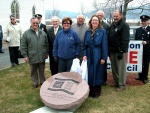 Jour de deuil - le dé
Jour de deuil - le dé
voilement du mo... -
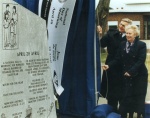 Jour de deuil - le dé
Jour de deuil - le dé
voilement du mo... -
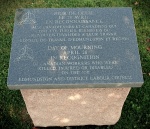 Jour de deuil - le mo
Jour de deuil - le mo
nument d’Edmund... -
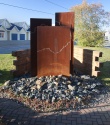 Jour de deuil - le mo
Jour de deuil - le mo
nument de Bathu...
-
 Jour de deuil - le mo
Jour de deuil - le mo
nument de Shipp... -
 Jour de deuil : carte
Jour de deuil : carte
des monuments ... -
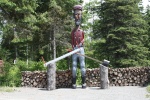 Le bûcheron Ti-Nel -
Le bûcheron Ti-Nel -
Kedgwick -
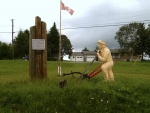 Le défricheur - Saint
Le défricheur - Saint
-Basile
-
 Le forgeron Michaud -
Le forgeron Michaud -
Saint-François... -
 Le Monument aux Pêche
Le Monument aux Pêche
urs, Escuminac -
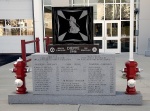 Le monument de la Bri
Le monument de la Bri
gade d’incendie... -
 Le policier Corbin -
Le policier Corbin -
Grand-Sault
-
 Le pompier Gagné - Ed
Le pompier Gagné - Ed
mundston -
 Mémorial des pêcheurs
Mémorial des pêcheurs
(1900) - Lamèq... -
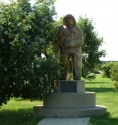 Sculpture en hommage
Sculpture en hommage
aux pêcheurs - ...
Hyperliens
Catégories
Notes
1. The research on worker’s monuments in Acadia was undertaken for the project ARUC (Community-University Research Alliance) “Re-Connecting with the History of Labour in New Brunswick: Historical Perspectives on Contemporary Issues” (LHTNB project). There are researchers from the Université de Moncton (Edmundston and Moncton), the University of New Brunswick in Fredericton and from unions. To learn more go to http://www.lhtnb.ca , and look up Labour Landmarks.
2. Archie Green, “Labour Landmarks Past and Present”, Labor's Heritage, vol. 6, issue 4 (spring, 1995), p. 26-53, and in the same issue, p. 54-63, “What is a Landmark? Inventory of American Labor Landmarks & National Park Service Theme Study of Labor Landmarks”. In the meantime, the Labor Heritage Foundation, an organisation supported by unions, launched its own catalogue “Inventory of American Labor Landmarks” on line at www.laborheritage.org/landmark.
3. The LHTNB project has identified labour landmarks as one of the five subjects of the research. Furthermore, an important part of its Website (www.lhtnb.ca) is dedicated to this subject.
4. For more information on the Escuminac Disaster, go to www.lhtnb.ca, under Labour Landmarks.
5. Most of the victims were people from Baie-Sainte-Anne, Bay du Vin and St. Margarets. A few lived in Lamèque, in Kouchibougouac and on Prince Edward Island.
6. “Escuminac: le monument à la mémoire de 35 pêcheurs dévoilé et béni hier”, L'Évangéline, June 20th, 1969, p. 1.
7. For example, on June 2009, the community of Escuminac and its surrounding areas commemorated the 50th anniversary of the disaster. Several activities were held at the Escuminac wharf and in the neighbouring village, Baie-Sainte-Anne. Hundreds of people listened to the survivors accounts. They watched a boat procession, and attended a commemorative ceremony, mass, as well as a play. For more information see “50 ans plus tard, Escuminac se souvient”, L'Acadie Nouvelle, June 18, p. 3 and Pascal Raiche-Nogue, “Escuminac, 50 ans après la tragédie. Survivants et familles se remémorent l'événement”, L'Acadie Nouvelle, June 19, p. 2.
8. “Monument du Désastre d'Escuminac désigné Lieu historique provincial”, News release, document NB650, Nouveau-Brunswick government, Culture and Sport Secretariat, July 4, 2001 and “Le monument d'Escuminac devient un lieu historique”, L'Acadie Nouvelle, July 2001, p. 7.
9. See Nicolas Landry, Éléments d'histoire des pêches. La péninsule acadienne du Nouveau-Brunswick, 1890-1950, Sillery (QC), Septentrion, 2005, p. 154-156.
10. Information collected by Nicole Lang from Robert Savoie, president of the Groupe du Patrimoine La Charrette Mystérieuse de Lamèque, October 28, 2009. See also Jean-Marie Pître, “Monument restauré à Lamèque”, L'Acadie Nouvelle, July 20, 2009, p. 4.
11. The April 28 commemoration became an international tradition taken up by many unions under various names in more than a 100 countries, and by the International Confederation of Trade Unions and the International Labour Organization. See, Ed Thomas, Dead But Not Forgotten. Morts, mais pas oubliés. Monuments to Workers. Les Monuments aux Travailleurs, Seldon Griffin Graphics Inc., 2001. See also the International Confederation of Trade Unions (www.ituc.csi.org/ ) and the International Labour Organization Websites (www.ilo.org/).
12. The Day of Mourning tradition was legitimized in 2000 when the NDP leader, Elizabeth Weir, introduced a bill to the Legislative Assembly of New Brunswick. The bill resulted in the enactment of the provincial Workers Mourning Day act.
13. For more information on the Day of Morning monuments in New Brunswick go to www.lhtnb.ca, under Labour Landmark. You can also find A Guide to Day of Mourning Monuments in New Brunswick produced by the Labour History in New Brunswick Project in collaboration with the New Brunswick Federation of Labour and the Canadian Labour Congress, 2009. There is also a short introduction video of the monuments on YouTube. See: April 28 avril Day of Mourning in New Brunswick / Jour de deuil au Nouveau-Brunswick at http://www.youtube.com/watch?v=eLjsZqa62gQ&feature=channel.
14. Lynne Caouette, “Boutique de forge Jos-B. Michau”, Revue de la Société historique du Madawaska, vol. 15, 3rd issue, Jully to September 1986, p. 12-19 and Marie-France Émond, “Monument à l'effigie de Jos B. Michaud”, Le Madawaska, Jully 8, 2009, p. C-1.
15. See the Website of the Kedgwick Forestry Museum at www.museeforestier.ca.
16. See the Dieppe Website under Monuments and Fire Brigade at www.dieppe.ca.
Bibliographie
Caouette, Lynne, « Boutique de forge Jos-B. Michaud », Revue de la Société historique du Madawaska, vol. XIV, no 3, juillet-septembre 1986, p. 12-19.
Frank, David, et Nicole Lang, Labour Landmarks in New Brunswick / Lieux historiques ouvriers au Nouveau-Brunswick, Edmonton, Comité canadien sur l'histoire du travail, 2010, 112 p.
Green, Archie, « Labour Landmarks Past and Present », Labor's Heritage, vol. 6, no 4, printemps 1995, p. 26-53.
Guide pour les monuments du Jour de deuil au Nouveau-Brunswick, dépliant produit par le Projet d'histoire du travail au Nouveau-Brunswick en collab. avec la Fédération des travailleurs et travailleuses du Nouveau-Brunswick et le Congrès du travail du Canada, 2009.
Journaux L'Acadie nouvelle (Caraquet), L'Évangéline (Moncton), Le Madawaska (Edmundston).
Landry, Nicolas, Éléments d'histoire des pêches : la péninsule acadienne du Nouveau-Brunswick, 1890-1950, Sillery (Qc), Septentrion, 2005, 308 p.
Thomas, Ed, Dead But Not Forgotten : Monuments to Workers / Morts, mais pas oubliés : les monuments aux Travailleurs, Hamilton (Ont.), E. Thomas, 2001, 160 p.
Volpé, Philippe, « Le sculpteur Albert Deveau et la commémoration du travail au Nouveau-Brunswick », Revue de la Société historique du Madawaska, vol. XXXVIII, nos 1-2, janvier-juin 2010, p. 48-59.

